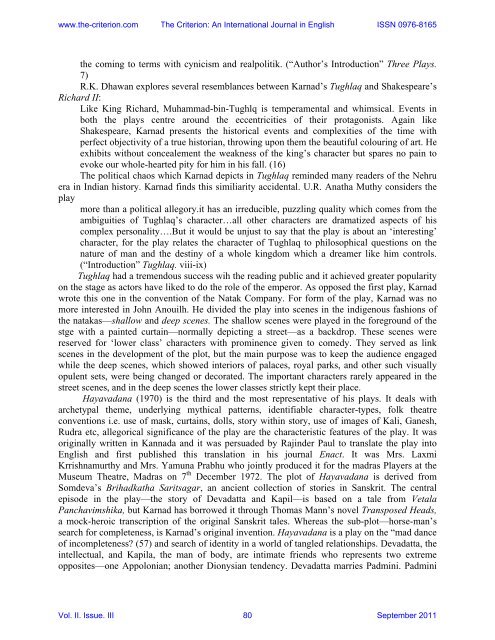Vol. II. Issue. III September 2011 - The Criterion: An International ...
Vol. II. Issue. III September 2011 - The Criterion: An International ...
Vol. II. Issue. III September 2011 - The Criterion: An International ...
Create successful ePaper yourself
Turn your PDF publications into a flip-book with our unique Google optimized e-Paper software.
www.the-criterion.com <strong>The</strong> <strong>Criterion</strong>: <strong>An</strong> <strong>International</strong> Journal in English ISSN 0976-8165<br />
the coming to terms with cynicism and realpolitik. (“Author’s Introduction” Three Plays.<br />
7)<br />
R.K. Dhawan explores several resemblances between Karnad’s Tughlaq and Shakespeare’s<br />
Richard <strong>II</strong>:<br />
Like King Richard, Muhammad-bin-Tughlq is temperamental and whimsical. Events in<br />
both the plays centre around the eccentricities of their protagonists. Again like<br />
Shakespeare, Karnad presents the historical events and complexities of the time with<br />
perfect objectivity of a true historian, throwing upon them the beautiful colouring of art. He<br />
exhibits without concealement the weakness of the king’s character but spares no pain to<br />
evoke our whole-hearted pity for him in his fall. (16)<br />
<strong>The</strong> political chaos which Karnad depicts in Tughlaq reminded many readers of the Nehru<br />
era in Indian history. Karnad finds this similiarity accidental. U.R. <strong>An</strong>atha Muthy considers the<br />
play<br />
more than a political allegory.it has an irreducible, puzzling quality which comes from the<br />
ambiguities of Tughlaq’s character…all other characters are dramatized aspects of his<br />
complex personality….But it would be unjust to say that the play is about an ‘interesting’<br />
character, for the play relates the character of Tughlaq to philosophical questions on the<br />
nature of man and the destiny of a whole kingdom which a dreamer like him controls.<br />
(“Introduction” Tughlaq. viii-ix)<br />
Tughlaq had a tremendous success wih the reading public and it achieved greater popularity<br />
on the stage as actors have liked to do the role of the emperor. As opposed the first play, Karnad<br />
wrote this one in the convention of the Natak Company. For form of the play, Karnad was no<br />
more interested in John <strong>An</strong>ouilh. He divided the play into scenes in the indigenous fashions of<br />
the natakas—shallow and deep scenes. <strong>The</strong> shallow scenes were played in the foreground of the<br />
stge with a painted curtain—normally depicting a street—as a backdrop. <strong>The</strong>se scenes were<br />
reserved for ‘lower class’ characters with prominence given to comedy. <strong>The</strong>y served as link<br />
scenes in the development of the plot, but the main purpose was to keep the audience engaged<br />
while the deep scenes, which showed interiors of palaces, royal parks, and other such visually<br />
opulent sets, were being changed or decorated. <strong>The</strong> important characters rarely appeared in the<br />
street scenes, and in the deep scenes the lower classes strictly kept their place.<br />
Hayavadana (1970) is the third and the most representative of his plays. It deals with<br />
archetypal theme, underlying mythical patterns, identifiable character-types, folk theatre<br />
conventions i.e. use of mask, curtains, dolls, story within story, use of images of Kali, Ganesh,<br />
Rudra etc, allegorical significance of the play are the characteristic features of the play. It was<br />
originally written in Kannada and it was persuaded by Rajinder Paul to translate the play into<br />
English and first published this translation in his journal Enact. It was Mrs. Laxmi<br />
Krrishnamurthy and Mrs. Yamuna Prabhu who jointly produced it for the madras Players at the<br />
Museum <strong>The</strong>atre, Madras on 7 th December 1972. <strong>The</strong> plot of Hayavadana is derived from<br />
Somdeva’s Brihadkatha Saritsagar, an ancient collection of stories in Sanskrit. <strong>The</strong> central<br />
episode in the play—the story of Devadatta and Kapil—is based on a tale from Vetala<br />
Panchavimshika, but Karnad has borrowed it through Thomas Mann’s novel Transposed Heads,<br />
a mock-heroic transcription of the original Sanskrit tales. Whereas the sub-plot—horse-man’s<br />
search for completeness, is Karnad’s original invention. Hayavadana is a play on the “mad dance<br />
of incompleteness? (57) and search of identity in a world of tangled relationships. Devadatta, the<br />
intellectual, and Kapila, the man of body, are intimate friends who represents two extreme<br />
opposites—one Appolonian; another Dionysian tendency. Devadatta marries Padmini. Padmini<br />
<strong>Vol</strong>. <strong>II</strong>. <strong>Issue</strong>. <strong>II</strong>I 80 <strong>September</strong> <strong>2011</strong>
















